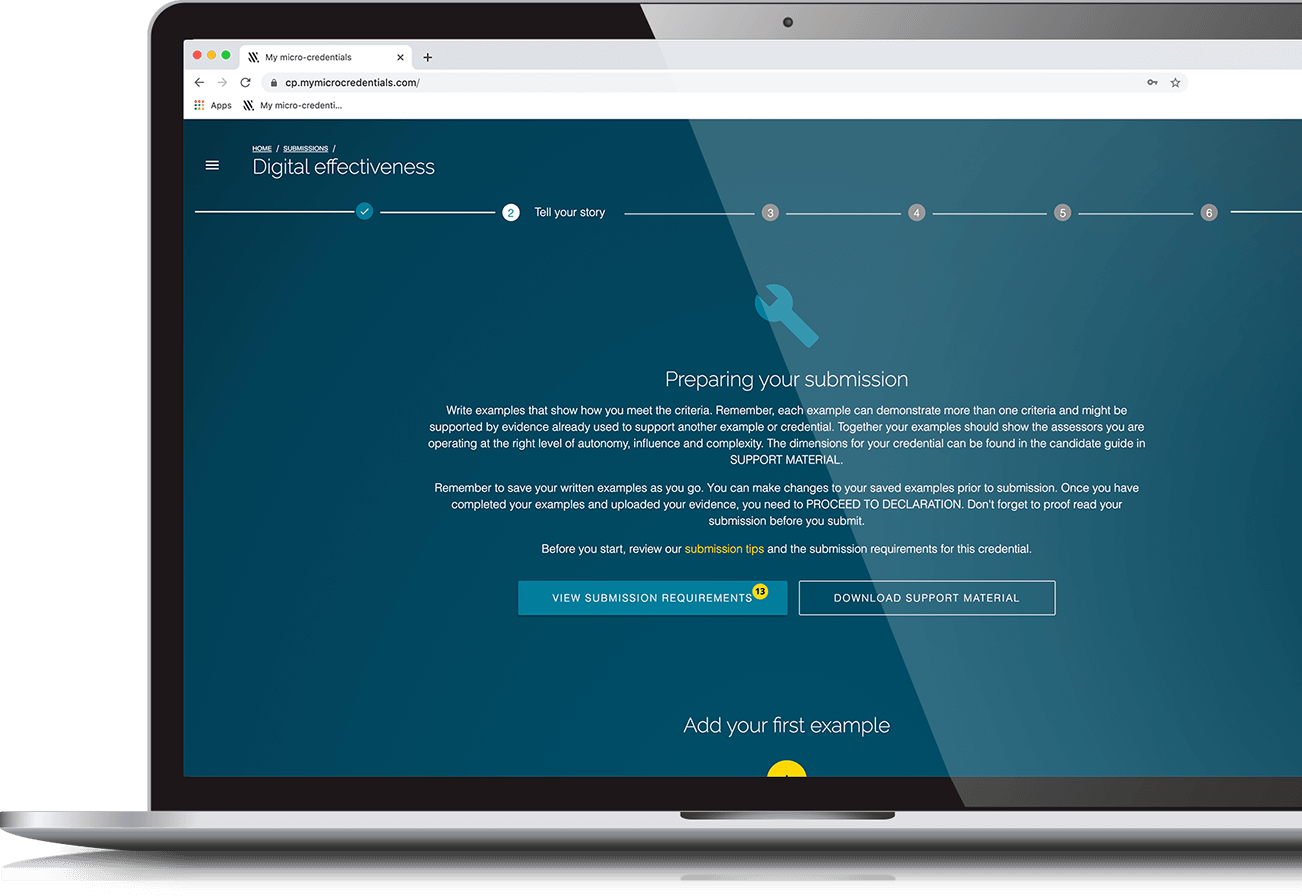How credentials work
The credential process is designed to be quick and straightforward. You don’t need to sit an exam or attend any classes to demonstrate your chosen skill.

Future-proof your career in 6 steps
-
Choose a credential that aligns with your work experience, skills and ambitions.
Choose a credential
Think about your experience and your ambitions. Which skills have you learned and which skills will take you where you want to go next. Once you’ve reflected on your experience and achievements – browse through our credentials to find the one that’s right for you.
We recommend you read the candidate guide that goes along with each credential to understand the requirements before registering.
-
Think of examples from your professional experience that demonstrate your skills
Think and reflect
Reflect on your professional experience and think about some of the examples from your work, like a project or initiative that will demonstrate the credential’s set criteria, and dimensions of autonomy, influence and complexity.
-
Gather evidence, such as documents, communications and reports, to support each example
Choose your examples and collect your evidence
Consider the examples from your work experience. We recommend you choose two to three examples. Examples can be used to demonstrate more than one of the credential criteria.
Evidence is the collection of documents you must provide to support the examples you’ll discuss in your reflective testimony. It is recommended that you select two to three pieces of evidence per example and that you consider your evidence before writing your reflective testimony.
-
Write a reflective testimony in our MyMicrocredentials Portal, that brings your examples and evidence together to show how you meet the criteria for the credential.
Write your reflective testimony
Your reflective testimony brings together your examples and evidence documents into an overall narrative. The reflective testimony will show how your examples demonstrate the criteria and level of the credential, and how the evidence documents support your examples.
You’ll create your reflective testimony by answering the questions in the Portal. They will guide you through the process, and there is additional help along the way. We recommend that before you submit you check all the elements of your submission for accuracy and that you’ve represented your work and experience honestly.
-
Complete a recorded video testimony where you’ll answer set questions about your skills
Undertake your video testimony
Once you have submitted your reflective testimony and evidence documents, your video testimony will be scheduled. This can be done at a time that suits you, but must be completed within two weeks of receiving the invitation. For the video testimony you’ll need to answer a series of questions expanding on your skills and knowledge, so it’s important to have a copy of your written submission with you so you can refer to it. Once you’ve completed your video testimony, it will be added to your submission record for assessment.
-
Celebrate and share your achievement
Celebrate
Congratulations! Once you receive confirmation of your result, you’ll be able to celebrate your achievement and share your digital badge. This signals to employers that you have attained recognition for your skills and helps to secure your place in the workforce of tomorrow.
Assessment of your submission
Once you’ve completed your video testimony, your entire submission will be assessed and you will be advised of the outcome. You may be asked to provide supplementary evidence during this process.
Unlike traditional learning assessments there is no grading scale for credentials. The final outcome will be that your submission has either satisfied or not satisfied the standard of achievement at the required level.

FAQs
What kind of examples are best to include in my submission?
When choosing your examples, ask yourself the following questions to ensure you meet the criteria for the credential:
- How do these examples show your capability?
- What was the context of the example?
- What did you set out to achieve?
- What was the outcome?
- Who were the stakeholders involved?
What kind of evidence do I need to provide?
The evidence you submit will depend on the credential you have chosen. Think of the evidence you submit as an artefact or piece of work that backs up the examples you provided. For the Communication credential, this could be a complex piece of content you wrote for a wide audience. For the Digital Marketing credential, it could be an audience insight document. Other successful candidates have also submitted project plans and strategy documents.
How do I prepare for the video testimonial?
You’ll be asked a series of questions focused on your skills and knowledge, with plenty of time given to prepare beforehand. It’s also an opportunity to elaborate on the details in your reflective testimony and evidence documents.
As some of the video questions will require you to refer to your examples and evidence, you must have a copy of your submission with you. We encourage you to read over your written submission and do a few practice videos until you feel comfortable.
Deakin has a video platform you can easily access through a link we’ll provide. You’ll need a computer or laptop with a camera and microphone, as well as good internet speeds.
How long will it take you to assess my work?
Your submission will normally be assessed within two weeks of completing your video testimony. This may be longer if you are asked to provide supplementary material.
How and when will I get the results?
Once your submission has been assessed, you will be notified of the outcome via email. Following this, your badge will be issued via Credly, Deakin’s trusted badging partner. You will be prompted to setup your Credly account (if required) and accept your badge. You’ll be provided with information on how to share your credential.
What happens if I fail - do I have to pay again, is there any appeal process?
You will normally already have been given an opportunity to provide further material during the assessment process. If your result is ‘Not Satisfied’ or ‘Awarded the Lower Level’ you will be given advice on how to improve your submission to achieve your desired outcome the next time you attempt the credential.
If you choose to reattempt the credential you will need to register again and pay the credential fee.
Is there an appeals system if I don’t agree with your assessment?
If you want to request more information about a decision, or to request a review, please contact ppc@deakin.edu.au
Get in touch
If you’d like to talk to anyone about how credentials can better prepare you or your workforce for the future of work, contact us today.

